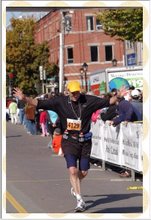Today we are on the third principle of diabetic running, recall that Principle #1 is that you are running for your life and Principle #2 is You need carbohydrates - even sugars. Today we are going to talk about Principle #3 Test strips are cheap running equipment.
We touched on this a bit in Principle #2, the need to keep our out blood sugar in the normal Blood Glucose range. Let me take a moment to put an explanation of what it means to measure your blood glucose level.
"When we speak about measuring blood glucose levels, it can be done two different ways. Blood glucose can be measured randomly from a sample taken at any time (called a "random blood sugar" or RBS). Blood glucose can also be measured in the "fasting" state, meaning that the person has not eaten or taken in any calories in the past 8 hours (usually this is done overnight and it is referred to as an overnight fast and is called a "fasting blood sugar" or FBS). In a person with normal insulin production and activity (a non-diabetic) blood sugar levels will return to "fasting" levels within 2-3 hours of eating. Diabetics (type 1 and type 2) may not be able to get their blood glucose down this quickly after a meal or drinking a calorie-containing drink.Remember, the normal fasting blood glucose level is between 70 and 110 g/dl."
(http://www.endocrineweb.com/diabetes/control.html)
We measure our Blood Glucose using a Monitor, these are an electronic device that when a small amount of blood is placed on a test strip it will give you an approx. Blood glucose level. While the Monitor itself is fairly cheap, the strips are 100$ Canadian a box. Usually a diabetic will test 4 or more times per day. So box will only last 3 weeks at the most. To put that in perspective, there are 18 million Diabetics in the US and Canada Each buying at least 17 box's of strips a year. The makers of these strips are pulling in a whopping 306,000,000,000$(306 Billion) a year just on strips.
Since we know it takes energy to run, and energy is the conversion of carbohydrates to glucose, we have to maintain our blood sugar levels even when we are running. When you first start out I recommend making sure that you test your blood sugar 1 hour before your activity. If you have to snack it will give the food time to digest and start flowing into your system. I find that anything under 10K rate does not really effect my blood sugar levels during a run as long as blood sugar is in the middle of the 70 -110 range.
Where I have to be careful is balancing those longer 10K + runs where we run more then a couple of hours. Since I run 10:1 Run/Walk ration during my LSD not a big issue to stop and test during one of the breaks. I have learned over time where the blood sugar drops is after the run. Yes, it nose dives down very quickly as my muscle now yell to my body to replace the depleted stores of energy.
So make sure you test yourself within 30 minutes of finishing and adjust your food intake accordingly. I have been know to have 1 cup of chocolate milk after a run. It has a good carb to protien ration to help recover from those long runs. I still have to be careful through out the day as the benefit of the run will last all day. Keeping your blood sugar level above 70 is very important as low Blood sugar can cause almost a drunken like state and I have been pulled over by the cops for weaving without having a drink. It happend once honest, thanks to the nice OPP outside of Bracebridge Ontario. Who understood the issue, and sent me on my way after a nice snack.
For those who don't know yes, testing your blood sucks, it hurts on occasion. Imagine sticking yourself with a pin 4 or more times a day in different fingers to make it bleed. They do toughen up but still who wants to go through that every day. Better to watch ourselves while we are healthy. I think tomorrow we will take a step back and talk about The causes of diabetes and how we can help prevent them.
The Diabetic Runner
Harry Jacobs
Wednesday, January 31, 2007
Tuesday, January 30, 2007
Principle #2, you need carbohydrates - even sugars
In the last post I talked a little about the first principle of running, which is "You are running for your life." Today's principle second principle is "You Need Carbohydrates - even sugars." Lets discuss what this means to the diabetic runner. Keep in mind even you non-diabetic types need carbs.
As a Diabetic we all know that carbs are our worst enemy. We are always watching are carbs and restricted our diets so that we keep our blood sugar within the non-diabetic range of 70-110mg/DL. For those reading my blog and don't know what Diabetes is here is a brief summary:
"Diabetes is a disorder characterized by hyperglycemia or elevated blood glucose (blood sugar). Our bodies function best at a certain level of sugar in the bloodstream. If the amount of sugar in our blood runs too high or too low, then we typically feel bad. Diabetes is the name of the condition where the blood sugar level consistently runs too high. Diabetes is the most common endocrine disorder. Sixteen million Americans have diabetes (almost 2 million Canadian as well), yet many are not aware of it. African Americans, Hispanics and Native Americans have a higher rate of developing diabetes during their lifetime. Diabetes has potential long term complications that can affect the kidneys, eyes, heart, blood vessels and nerves."(http://www.endocrineweb.com/diabetes/index.html).
"Type 2 Diabetes is more common than Type 1 Diabetes. Whereas Type 1 Diabetes was characterized by the onset in young persons (average age at diagnosis = 14), Type 2 Diabetes usually develops in middle age or later. This tendency to develop later in life has given rise to the term "adult onset diabetes". The typical Type 2 Diabetes patient is overweight although there are exceptions. In contrast to Type 1 Diabetes, symptoms often have a more gradual onset. Type 2 Diabetes is associated with insulin resistance rather than the lack of insulin like seen in Type 1 Diabetes. This often is obtained as a hereditary tendency from one's parents. Insulin levels in these patients are usually normal or higher than average but the body's cells are rather sluggish to respond to it. This lack of insulin activity results in higher than normal blood glucose levels."(http://www.endocrineweb.com/diabetes/2diabetes.html)
Carbohydrates make your blood sugar rise, Type II diabetic's experiance insulin resitance making it harder for the cells to absorb the blood sugar out of our blood stream. One of the main ways of controling this is to restrict and watch are intake of carbohydrates. As runners we know that we need Carbohydrates in order to fuel our runs. We must strive for a balance of carbs in our diet to keep our blood sugar in the control range as well as fuel our runs. Low Blood sugar can lead to some nasty side effects including passing out. Which I for one would like to avoid.
Experiment with your diet is the only way to figure out what is the right amount of carbs for you. Test, your Blood sugar often when starting out those longer distances. Before, During and after your run and through out the day, but more on that in a later entry. Learn about the GI diet and which foods are indexed for slower digestion into your blood stream, For example, Mashed potatoes will make your blood sugar rise faster then a baked potatoe.
Follow your meal plan, I suggest you may be looking at 1800-2400 calories a day if not more. Fifty percent of your diet should be carbs. That would be 900 -1200 a day just in carbs. 1 Gram of carbs is 4 calories, That means that you will need to eat between 225-300 Grams of carbs. This equals out to, 15-20 car exchanges. This is a guide line, not a diet, test yourself before as you add carbs, you may want to increase your carbs slowly.
My recommendation eat smaller portions more frequently. I found with my half marathon training that I was eating every 3 hours in the last 6 weeks of my program to keep my carbs over 4.0 (70mg/dl). Do what works for you, talk to your dietician, everyone is different what I do may not be right for you.
Best advice on carbs, avoid simple sugars you know the kind anything that ends in -ose. Also avoid shopping in the aisles of your favorite grocery store. Keep to fresh fruit, veggies, meat, along with dairy and some frozen. Only go in the Aisles when you need dressing, oils etc....
Later
The diabetic Runner
Harry Jacobs
As a Diabetic we all know that carbs are our worst enemy. We are always watching are carbs and restricted our diets so that we keep our blood sugar within the non-diabetic range of 70-110mg/DL. For those reading my blog and don't know what Diabetes is here is a brief summary:
"Diabetes is a disorder characterized by hyperglycemia or elevated blood glucose (blood sugar). Our bodies function best at a certain level of sugar in the bloodstream. If the amount of sugar in our blood runs too high or too low, then we typically feel bad. Diabetes is the name of the condition where the blood sugar level consistently runs too high. Diabetes is the most common endocrine disorder. Sixteen million Americans have diabetes (almost 2 million Canadian as well), yet many are not aware of it. African Americans, Hispanics and Native Americans have a higher rate of developing diabetes during their lifetime. Diabetes has potential long term complications that can affect the kidneys, eyes, heart, blood vessels and nerves."(http://www.endocrineweb.com/diabetes/index.html).
"Type 2 Diabetes is more common than Type 1 Diabetes. Whereas Type 1 Diabetes was characterized by the onset in young persons (average age at diagnosis = 14), Type 2 Diabetes usually develops in middle age or later. This tendency to develop later in life has given rise to the term "adult onset diabetes". The typical Type 2 Diabetes patient is overweight although there are exceptions. In contrast to Type 1 Diabetes, symptoms often have a more gradual onset. Type 2 Diabetes is associated with insulin resistance rather than the lack of insulin like seen in Type 1 Diabetes. This often is obtained as a hereditary tendency from one's parents. Insulin levels in these patients are usually normal or higher than average but the body's cells are rather sluggish to respond to it. This lack of insulin activity results in higher than normal blood glucose levels."(http://www.endocrineweb.com/diabetes/2diabetes.html)
Carbohydrates make your blood sugar rise, Type II diabetic's experiance insulin resitance making it harder for the cells to absorb the blood sugar out of our blood stream. One of the main ways of controling this is to restrict and watch are intake of carbohydrates. As runners we know that we need Carbohydrates in order to fuel our runs. We must strive for a balance of carbs in our diet to keep our blood sugar in the control range as well as fuel our runs. Low Blood sugar can lead to some nasty side effects including passing out. Which I for one would like to avoid.
Experiment with your diet is the only way to figure out what is the right amount of carbs for you. Test, your Blood sugar often when starting out those longer distances. Before, During and after your run and through out the day, but more on that in a later entry. Learn about the GI diet and which foods are indexed for slower digestion into your blood stream, For example, Mashed potatoes will make your blood sugar rise faster then a baked potatoe.
Follow your meal plan, I suggest you may be looking at 1800-2400 calories a day if not more. Fifty percent of your diet should be carbs. That would be 900 -1200 a day just in carbs. 1 Gram of carbs is 4 calories, That means that you will need to eat between 225-300 Grams of carbs. This equals out to, 15-20 car exchanges. This is a guide line, not a diet, test yourself before as you add carbs, you may want to increase your carbs slowly.
My recommendation eat smaller portions more frequently. I found with my half marathon training that I was eating every 3 hours in the last 6 weeks of my program to keep my carbs over 4.0 (70mg/dl). Do what works for you, talk to your dietician, everyone is different what I do may not be right for you.
Best advice on carbs, avoid simple sugars you know the kind anything that ends in -ose. Also avoid shopping in the aisles of your favorite grocery store. Keep to fresh fruit, veggies, meat, along with dairy and some frozen. Only go in the Aisles when you need dressing, oils etc....
Later
The diabetic Runner
Harry Jacobs
Monday, January 29, 2007
Running with Diabetes
Greetings,
I have decided to start a blog on running, OK, you think to yourself, "Oh no not another running blog". Well follow along, my adventures as I gear up for two big runs over the next year.
First up, the Bluenose full marathon here in Halifax. This marathon is on May 20, 2007 and covers a Halifax loop, then across the bridge to Dartmouth. Its a hill course so I am not expecting to break any land speed records.
Second, I will be registering for Team Diabetes. My goal is to run the Goofy at Disney in Orlando. What makes the Goofy special is it is a back to back Half marathon on Saturday Jan 5, 2008, followed by a full marathon on Sunday Jan 6, 2008.
First a bit of history about me, I am a Type Two Diabetic, and was diagnosed in May 2005. My doctor basically told me to shape up and change my lifestyle or suffer the consequences of unchecked blood sugar. So I shaped up, started a diet and bought a pair of running shoes.
I went from 300lbs. 46" waist, to 205lbs 36" waist in 18 months. My thoughts on exercise went from getting up from my computer walking to the fridge and back, to running my first 1/2 marathon in October 2006 in PEI. What a blast, it hurt a bit but was worth every step.
Why is running good for me(yes and you too):
1. Lowers blood glucose levels on the average (more below)
2. Permits muscles to take up glucose without insulin
3. Improves the body's ability to make use of insulin
4. Decreases the total amount of insulin your body puts out in a day(this is actually a good thing - as a Type II diabetic, you're workingyour beta cells to death - literally. That's why Type IIs tend toprogress to needing insulin).
5. Improves emotional outlook (being a diabetic sucks).
6. Improves cardiovascular fitness (guess what the #1 killer of Type II Diabetic's is?).
To finish off today's first post I will talk about the first principle of running. "You are running for your life.". As a Type II diabetic, the only way to live, is to lead a healthy lifestyle. A balance of healthy eating and exercise. Not everyone can be a runner, but there are alternatives that have less impact on the body. So apply your favorite activity to this principle. Please see your doctor and other health proffessional for advice on the type of exercise you may be suited for. Don't forget to make sure you have your doctor's approval for any exercise you may wish to start.
Make sure as a running diabetic you take extra care to avoid even the smallest of injuries. So take your time increasing your activity for running I generally take more time to build my base Kilometers up. Also make sure you spend time picking out the right shoes and socks. Go to a running store, I recommend the Running Room. There folks have great knowlege on shoes and it is the most important purchase of any runner.
As a Diabetic I recommend the double layered socks to prevent blisters. They are available at the Running Room as well. We have to take extra special care of our feet in order to prevent problems later on.
How much money you want to spend after the shoes and socks is up to you. There are a lot of gadgets and technical clothes to spend your money on. Are they worth the coin, in my opinion yes. But to start off I recommend a pair of running shoes look to spend at least 150$ and socks 14$ for a pair. Then any old sweats and shorts will do to start your program.
Remember you are Running for your life, so take care of the one you have, you only get one shot at it and nobody gets out alive.
The Diabetic Runner
Harry Jacobs
I have decided to start a blog on running, OK, you think to yourself, "Oh no not another running blog". Well follow along, my adventures as I gear up for two big runs over the next year.
First up, the Bluenose full marathon here in Halifax. This marathon is on May 20, 2007 and covers a Halifax loop, then across the bridge to Dartmouth. Its a hill course so I am not expecting to break any land speed records.
Second, I will be registering for Team Diabetes. My goal is to run the Goofy at Disney in Orlando. What makes the Goofy special is it is a back to back Half marathon on Saturday Jan 5, 2008, followed by a full marathon on Sunday Jan 6, 2008.
First a bit of history about me, I am a Type Two Diabetic, and was diagnosed in May 2005. My doctor basically told me to shape up and change my lifestyle or suffer the consequences of unchecked blood sugar. So I shaped up, started a diet and bought a pair of running shoes.
I went from 300lbs. 46" waist, to 205lbs 36" waist in 18 months. My thoughts on exercise went from getting up from my computer walking to the fridge and back, to running my first 1/2 marathon in October 2006 in PEI. What a blast, it hurt a bit but was worth every step.
Why is running good for me(yes and you too):
1. Lowers blood glucose levels on the average (more below)
2. Permits muscles to take up glucose without insulin
3. Improves the body's ability to make use of insulin
4. Decreases the total amount of insulin your body puts out in a day(this is actually a good thing - as a Type II diabetic, you're workingyour beta cells to death - literally. That's why Type IIs tend toprogress to needing insulin).
5. Improves emotional outlook (being a diabetic sucks).
6. Improves cardiovascular fitness (guess what the #1 killer of Type II Diabetic's is?).
To finish off today's first post I will talk about the first principle of running. "You are running for your life.". As a Type II diabetic, the only way to live, is to lead a healthy lifestyle. A balance of healthy eating and exercise. Not everyone can be a runner, but there are alternatives that have less impact on the body. So apply your favorite activity to this principle. Please see your doctor and other health proffessional for advice on the type of exercise you may be suited for. Don't forget to make sure you have your doctor's approval for any exercise you may wish to start.
Make sure as a running diabetic you take extra care to avoid even the smallest of injuries. So take your time increasing your activity for running I generally take more time to build my base Kilometers up. Also make sure you spend time picking out the right shoes and socks. Go to a running store, I recommend the Running Room. There folks have great knowlege on shoes and it is the most important purchase of any runner.
As a Diabetic I recommend the double layered socks to prevent blisters. They are available at the Running Room as well. We have to take extra special care of our feet in order to prevent problems later on.
How much money you want to spend after the shoes and socks is up to you. There are a lot of gadgets and technical clothes to spend your money on. Are they worth the coin, in my opinion yes. But to start off I recommend a pair of running shoes look to spend at least 150$ and socks 14$ for a pair. Then any old sweats and shorts will do to start your program.
Remember you are Running for your life, so take care of the one you have, you only get one shot at it and nobody gets out alive.
The Diabetic Runner
Harry Jacobs
Subscribe to:
Posts (Atom)





